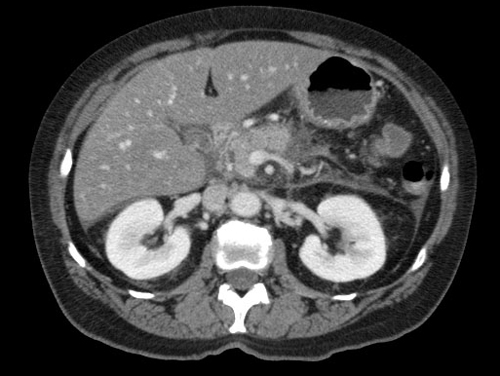CT-Scan

A computed tomography (CT) scan uses X-rays to make detailed pictures of structures inside of the body.
A CT scan can be used to study all parts of your body, such as the chest, belly, pelvis, or an arm or leg. It can take pictures of body organs, such as the liver, pancreas, intestines, kidneys, bladder, adrenal glands, lungs, and heart.
During the test, you will lie on a table that is attached to the CT scanner, which is a large doughnut-shaped machine. The CT scanner sends X-rays through the body area being studied. Each rotation of the scanner takes less than a second and provides a picture of a thin slice of the organ or area. All of the pictures are saved as a group on a computer. They also can be printed.
An iodine dye (contrast material) is often used to make structures and organs easier to see on the CT pictures. The dye may be used to check blood flow, find tumors, and look for other problems. The dye can be used in different ways. It may be put in a vein (IV) in your arm, or it may be placed into other parts of your body (such as the rectum or a joint) to see those areas better.

IT CAN BE USED TO SCAN:
- Chest (thorax): A CT scan of the chest can look for problems with the lungs, heart, esophagus, the major blood vessel (aorta), or the tissues in the center of the chest. Some common chest problems a CT scan may find include infection, lung cancer, a pulmonary embolism, and an aneurysm. It also can be used to see if cancer has spread into the chest from another area of the body.
- Abdomen: A CT scan of the abdomen can find cysts, abscesses, infection, tumors, an aneurysm, enlarged lymph nodes, foreign objects, bleeding in the belly, diverticulitis, inflammatory bowel disease, and appendicitis.
- Urinary tract: A CT scan of the kidneys, ureters, and bladder is called a CT KUB or CT urogram. This type of scan can find kidney stones, bladder stones, or blockage of the urinary tract. See a picture of a CT of diseased kidneys . A special type of CT scan, called a CT intravenous pyelogram (IVP), uses injected dye (contrast material) to look for kidney stones, blockage, growths, infection, or other diseases of the urinary tract.
- Liver: A CT scan can find liver tumors, bleeding from the liver, and liver diseases. A CT scan of the liver can help determine the cause of jaundice. * Pancreas. A CT scan can find a tumor in the pancreas or inflammation of the pancreas (pancreatitis).
- Gallbladder and bile ducts: A CT scan can be used to check for blockage of the bile ducts. Gallstones occasionally show up on a CT scan. But other tests, such as ultrasound, usually are used to find problems with the gallbladder and bile ducts.
- Adrenal glands: A CT scan can find tumors or enlarged adrenal glands.
- Spleen: A CT scan can be used to check for an injury to the spleen or the size of the spleen.
- Pelvis: A CT scan can look for problems of organs in the pelvis. For a woman, these include the uterus, ovaries, and fallopian tubes. For a man, the pelvic organs include the prostate gland and the seminal vesicles.
- Arm or leg: A CT scan can look for problems of the arms or legs, including the shoulder, elbow, wrist, hand, hip, knee, ankle, or foot.
courtesy of WebMd.com
